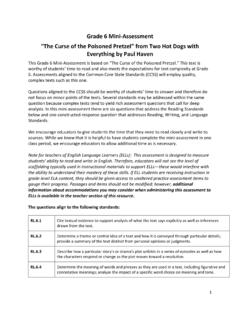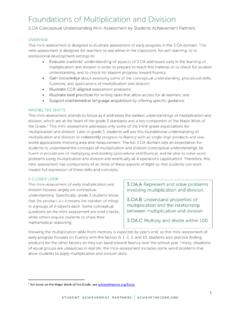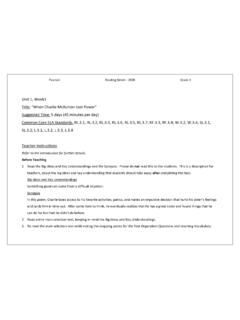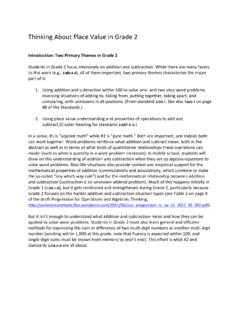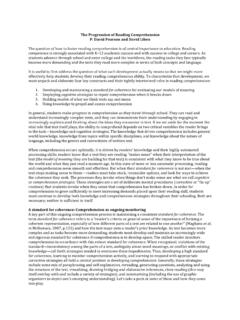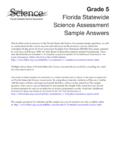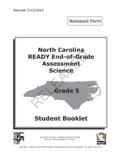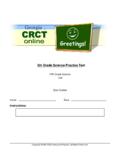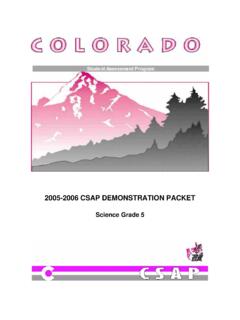Transcription of Grade 5 Informational Mini-Assessment - Achieve the Core
1 1 Grade 5 Informational Mini-Assessment Looking for Lunar Ice This Grade 5 Mini-Assessment is based on the text Looking for Lunar Ice, an excerpt from Far-Out Guide to the Moon by Mary Kay Carson. This text is considered to be worthy of students time to read and also meets the expectations for text complexity at Grade 5. Assessments aligned to the Common Core State Standards (CCSS) will employ quality, complex texts such as this one. Questions aligned to the CCSS should be worthy of students time to answer and therefore do not focus on minor points of the text. Questions also may address several standards within the same question because complex texts tend to yield rich assessment questions that call for deep analysis. In this Mini-Assessment there are six selected-response questions and one paper/pencil equivalent of technology enhanced items that address the Reading Standards listed below.
2 Additionally, there is an optional writing prompt, which is aligned to Reading, Writing, and Language standards. We encourage educators to give students the time that they need to read closely and write to the source. While we know that it is helpful to have students complete the Mini-Assessment in one class period, we encourage educators to allow additional time as is necessary. Note for teachers of English Language Learners (ELLs): This assessment is designed to measure students ability to read and write in English. Therefore, educators will not see the level of scaffolding typically used in instructional materials to support ELLs these would interfere with the ability to understand their mastery of these skills. If ELL students are receiving instruction in Grade -level ELA content, they should be given access to unaltered practice assessment items to gauge their progress.
3 Passages and items should not be modified; however, additional information about accommodations you may consider when administering this assessment to ELLs is available in the teacher section of this resource. The questions align to the following standards: Quote accurately from a text when explaining what the text says explicitly and when drawing inferences from the text. Determine two or more main ideas of a text and explain how they are supported by key details; summarize the text. Explain the relationships or interactions between two or more individuals, events, ideas, or concepts in a historical, scientific, or technical text based on specific information in the text. Determine the meaning of general academic and domain-specific words and phrases in a text relevant to a Grade 5 topic or subject area.
4 Explain how an author uses reasons and evidence to support particular points in a text, identifying which reasons and evidence support which point(s). Write informative/explanatory texts to examine a topic and convey ideas and information clearly. 2 Produce clear and coherent writing in which the development and organization are appropriate to task, purpose, and audience. Draw evidence from literary or Informational texts to support analysis, reflection, and research. Demonstrate command of the conventions of standard English grammar and usage when writing or speaking. Demonstrate command of the conventions of standard English capitalization, punctuation, and spelling when writing. Use knowledge of language and its conventions when writing, speaking, reading, or listening.
5 3 Contents Grade 5 Mini-Assessment Looking for Lunar Ice Print for students .. 4 Information for Teachers: Quantitative and Qualitative Analyses of the Text .. 13 Question Annotations: Correct Answer(s) and Distractor Rationales .. 15 Using the Mini-Assessments with English Language 20 Additional Resources for assessment and CCSS Implementation .. 23 The assessment questions in this document align with the CCSS and reflect the instructional shifts implied by the standards. To learn more about these topics, please go to the following link: 4 Grade 5 Mini-Assessment Looking for Lunar Ice Today you will read a passage about scientists search for water on the Moon. You will then answer several questions based on the text. I will be happy to answer questions about the directions, but I will not help you with the answers to any questions.
6 You will notice as you answer the questions that some of the questions have two parts. You should answer Part A of the question before you answer Part B, but you may go back and change your answer to Part A if you want to. Take as long as you need to read and answer the questions. If you do not finish when class ends, come see me to discuss the ways you may have additional time. Now read the passage and answer the questions. I encourage you to write notes in the margin as you read the passage. Looking for Lunar Ice from Far-Out Guide to the Moon by Mary Kay Carson 1 Lunar rocks lost their water long ago. So the Moon is a totally dry world, right? Not necessarily. Remember that the Moon is covered in impact craters. Many of those impacting comets, asteroids, and meteoroids delivered some water ice to the Moon.
7 The ice carried by space rocks scattered across the lunar surface upon impact. Sunlight quickly evaporated most of the ice. But scientists suspect that some of that water ice still survives on the Moon. 2 The only way water can be preserved on the in extremely cold areas, explains lunar scientist Alan Binder. The coldest places on the Moon are where the Sun never shines. Some of the Moon s deep craters cast permanent shadows. The Moon s north and south poles have some always-dark craters. How much ice survives in these cold trap craters? Scientists are working to find out. Finding a lot of ice on the Moon would be a big deal. If humans are going to build a moon base someday, they will need water. Not having to bring water from Earth would be a big help.
8 5 SEARCHING THE SHADOWS 3 Two decades passed without a single lunar visitor after the last astronaut walked on the Moon in 1972. Another spacecraft finally headed to our orbiting neighbor in 1994. No humans were aboard Clementine when it launched. It was a robotic space probe. Clementine mapped the Moon s surface. It found permanently dark craters near the Moon s poles. Clementine s radar also found hints of ice in those craters. But when radar telescopes on Earth looked, they could not find the lunar ice. So was it really there? 4 Lunar Prospector went to find out in 1998. The small space probe scanned the Moon s surface. Seven weeks after orbiting, Lunar Prospector scientists made a big announcement. We have found water at both lunar poles, Alan Binder told reporters in March of 1998.
9 He was in charge of the Lunar Prospector mission. Water ice crystals seemed to be mixed in with the dusty lunar soil. Lunar Prospector scientists said that a small lake s worth of water lay scattered as frost near the Moon s poles. 5 How could scientists be sure this time? They sacrificed their spacecraft to find out. In July of 1999, engineers sent Lunar Prospector crashing into a dark crater at the Moon s south pole. Scientists figured that the crash s dust cloud would have some water vapor in it. But no water showed up. The mystery of water of the Moon would take another ten years to solve. MORE THAN EXPECTED 6 When the robotic explorer Lunar Reconnaissance Orbiter flew to the Moon in 2009, another spacecraft piggybacked on it. The Lunar Crater Observation and Sensing Satellite (LCROSS) aimed to finally answer whether or not there is ice on the Moon.
10 Soon after launch, LCROSS separated from its ride and headed for crater Cabeus near the Moon s south pole. First LCROSS sent its booster rocket crashing into the crater. The spacecraft quickly radioed back what it saw in the debris cloud. Only minutes later LCROSS slammed itself into the crater, too, as astronomers on Earth searched the kicked-up cloud for water and found it. 6 This illustration shows the LCROSS studying the debris plume from its crashed rocket booster. (Courtesy of NASA) 7 Yes, we found water, LCROSS scientist Anthony Colaprete told reporters during the big announcement in late 2009. And we didn t find just a little bit. They d found enough water to fill a dozen two-gallon buckets. There s likely a lot of ice on the Moon.

